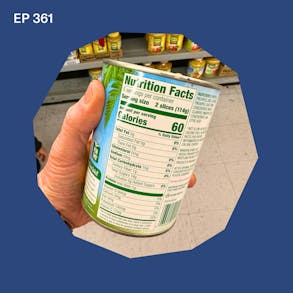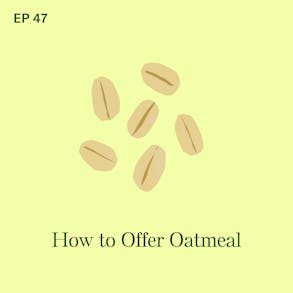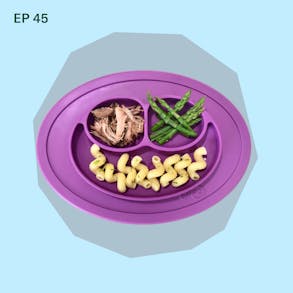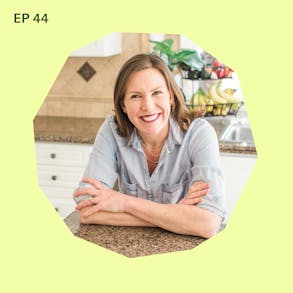Label Reading 102 for Babies: Saturated Fats, Fiber, and %DV
In this episode we're talking about:
- Why you shouldn't worry about the amount of saturated fat in your baby's food…it does matter later in life though
- Why added or functional fibers in foods are not appropriate for babies…and what fiber foods they should eat instead
- How to evaluate the percent daily value (%DV) when it's not based on data that is applicable to babies
- Episode 351 -

LISTEN TO THIS EPISODE
Episode Description
Do you need to worry about how much saturated fat your baby eats? In this episode we’re looking at 3 additional areas of the nutrition facts panel as they pertain to babies’ intake: saturated fats, fiber and the percent daily value (%DV). See episode 351 for Label Reading 101 for info about added sugars, sodium and iron for babies.
Links from this Episode
- Baby-Led Weaning with Katie Ferraro program with the 100 First Foods™ Daily Meal Plan, join here: https://babyledweaning.co/program
- Baby-Led Weaning for Beginners free online workshop with 100 First Foods™ list to all attendees, register here: https://babyledweaning.co/baby-led-weaning-for-beginners
Other episodes related to this topic:

Latest Episodes






Katie Ferraro (48s):
Coming in tops on the list of work things I thought I was gonna loathe, but I ended up loving YouTube. We have a YouTube channel. It's about a year old. It's finally picking up steam and there are so many valuable videos over there, If. you want to see what starting solid foods looks like. I know I'm telling you about a YouTube channel while you're listening to a podcast. But If, you have a chance, check it out. Our channel's baby led weaning, it's literally the handle name. So original I know If, you see something you like, subscribe, get notified each week when there's new videos. That's YouTube.com/babyledweaning. And I think part of the problem with all of these questions that we're getting about saturated fat for babies is that other accounts or non dietitians who are giving nutrition advice are reading these recommendations.
Katie Ferraro (1m 29s):
Oh, limit saturated fat to less than 10% of calories. And for one to three year olds, that means less than 10 grams of saturated fat. So now we have all these parents being like, oh my gosh, I'm counting the grams of saturated fat for my baby. You don't need to do that. Okay? That recommendation does not apply to children younger than age two. So stop stressing about saturated fat for your baby. Hey there. I'm Katie Ferraro, registered dietitian, college nutrition professor and mom of seven specializing in babyled Weaning here on the Baby Led Weaning Made Easy podcast. I help you strip out all of the noise and nonsense about feeding, leaving you with the confidence and knowledge you need to give your baby a safe start to solid foods using baby-led weaning.
Katie Ferraro (2m 13s):
Well, hello there and welcome back. In today's episode, we're gonna be talking a little bit more about what to look at on the Nutrition Facts panel or the Food Label when you're choosing Foods that you're going to offer to your baby. Now, I called this episode Nutrition Label Reading 102, and that's because of while back we did 101 So If. you go back to episode 351, I did Label Reading 101, what to Look for in Foods that you Offer your baby. And in that episode we went through sodium sugars and kind of differentiated between naturally occurring sugars and added sugars. And then we also did iron in that episode, but I didn't want it to get too long. And then as soon as that one went live, a ton of people were asking questions about other nutrients. So I was like, Hey, I need to schedule kind of a part two. So this is like part two of Label Reading. And in this episode we're gonna be looking in particular at Saturated, Fats Fiber and then percent DV or the percent daily value.
Katie Ferraro (3m 1s):
'cause that area can get a little tricky. And I don't want you to get overwhelmed when you look at a food Label 'cause there really are a few key areas. I firmly believe that sugar, sodium, and iron are the three most important ones. But if you're like, okay, I got it and I'm like seeing some more things on this Label and I wanna know what they're about, I've got those answers for you in this episode. But If, you want that first part of it. Episode 3 5 1 is Label Reading 1 0 1 about sugar, sodium, and iron. And that's at blwpodcast.com/351. And I like to start these mini baby-led weaning training episodes with the BLW tip of the day. And today's tip is, please remember that the nutrition facts panel information that you see on food labels in the United States, they are reflective of diets intended for children four years of age or older and adults.
Katie Ferraro (3m 48s):
Now of course, there's absolutely no way to encapsulate all of the nuanced, varied nutrition needs of a four year old up to a 94 year old on the side of like your pasta container. Okay? So what I want you to take away from that is that when we're talking about nutrition information for Babies, I'm talking about your baby in the six to 12 month window and that none of the dietary reference intakes. So those are the values that the US government sets that says, don't fall below this or your baby might have nutrition problems. None of them apply to Babies in particular. Okay? And because you can't ethically design a study that would analyze like what happens if Babies don't get enough calcium? Let's restrict human milk or breast milk or formula from them and see what happens.
Katie Ferraro (4m 30s):
Okay? It doesn't work like that. And so a lot of what we know about nutrition in the six to 12 month age, these are adequate intake levels. And I kind of explained that in the previous episode when we talked about nutrition facts panels, but that they're not based on hard and fast science. So I don't want you to stress out when you see numbers, oh my gosh, my baby needs this amount of X, Y, or Z. The whole point of learning how to eat is about giving your baby ample opportunity to learn how to eat the Foods. I am a Registered dietician. It like makes my skin crawl to even hear myself talking about milligrams and micrograms because that is not what is important in general. Well, baby nutrition If, you are a pediatric dietician and you are working with a medically fragile population. Heck yeah, you better know your micrograms, milligrams, et cetera.
Katie Ferraro (5m 12s):
But for your parent of a baby who doesn't have a medical condition, I don't want them counting calories or grams of Saturated fat or grams of Fiber. But I do provide this information because I know when you're looking at labels it can be confusing. And I want to kind of help you cut through the noise. So just remember that the info that's on the Nutrition Facts panel, it's not directed at your baby, it's for adults. Alright, let's get started looking at Saturated, Fats, Fiber and percent daily value. I'm gonna start with Saturated Fats because I have a live office hours component of my program. And so for parents and caregivers, they come on each week and they can ask questions. And in the last two weeks on office hours, I've never had this before. I had three questions about Saturated fat or cholesterol. So I don't know what's going on, if there's someone else out there like putting ideas in your heads that you need to be concerned about your Saturated fat intake for your baby.
Katie Ferraro (5m 58s):
But please know that you do not need to look at nor be concerned with the amount of Saturated Fats in the Foods that you're offering your baby. We were talking about eggs in this particular question and the mom was asking, you know, we were analyzing different ways to prepare eggs for your baby. And obviously we don't recommend any one food every day, but she's like, I feel like I'm offering my baby a lot of eggs. Is that too much cholesterol? And so oftentimes eggs get associated with cholesterol, but it's the dietary cholesterol like in the Foods that you eat, that's not what affects your blood cholesterol levels. So for those of you with family histories of heart disease, they do tell you like, okay, yeah, you know, you don't wanna like pump your baby full of Foods that are gonna increase their risk of heart disease. But also when your baby's learning how to eat, the last thing you need to be worried about is the Saturated fat content of the Foods that you're eating.
Katie Ferraro (6m 41s):
That's my professional dietician opinion. And so this notion of, oh, well if I eat cholesterol, my cholesterol goes up. It doesn't work like that. It's the Saturated fat content in the Foods that we eat that raise our bad cholesterol or our L D L cholesterol levels. So again, it's not the dietary cholesterol in your Foods that raise cholesterol in adults, it's the Saturated fat. So this trickles down to parents being like, well then I don't wanna give my baby Saturated fat. Well, guess what? Saturated? Fats come primarily from animal Foods. And yes, when you get older, we don't want most of those Fats being from animal Foods, it's better to have the unsaturated Fats, many of which come from plant Foods and then a little bit of animal food. But for Babies, when we're starting solid Foods, my primary concern is safety. And we know that the fattier, the cut of meat, okay, that fat, when you cook it, it liquefies and it lubricates the protein strands and it makes it safer and easier for your baby to swallow.
Katie Ferraro (7m 29s):
So I don't want you offering your baby low fat meats, like 96% lean ground beef or chicken breast or Turkey breast, okay? We always talk about the higher fat cuts of meat in my program and how to choose those and select those and make them safe for Babies. And you never have to worry about the Saturated fat content. Hey, we're gonna take a quick break, but I'll be right back.
Katie Ferraro (8m 41s):
So If, you're trying to pick different cuts of meat. The baby led weaning with Katie Ferraro program has a hundred first Foods content library that shows you for each of the protein Foods. Okay? These are the cuts. This is how you pick it. This is how you make it for the different ages and stages of your baby If. you want help making all of those a hundred first Foods. You can go to babyledweaning.co and click on program for more information. And I also wanna remind parents who are stressing out about Saturated Fats that the recommendations to limit Saturated fat to less than 10% of calories does not apply to those younger than two. So I think what's happening is like some social media accounts are like taking this adult information and extrapolating it to an infant population, and it just doesn't work like that.
Katie Ferraro (9m 23s):
Sometimes in other pediatric nutrition references, you'll see the recommendation to have less than 10 grams of Saturated fat, okay? 'cause that's for children age one to three, and that's because that's based on a 1000 calorie diet. So less than 10% of the calories coming from Saturated fat would be less than 10 grams of Saturated fat. Don't stress, don't count your baby's grams of Saturated fat because again, this does not apply to those younger than two. And we run into this problem in the United States with different nutrition bodies put out conflicting advice where like, wait a minute, but they said for one to three year old it should be less than 10 grams. And this other branch is saying that, oh, for less than two year olds, you don't need to worry about it. I'm here to tell you that for your six to 12 month old baby, you do not need to be worried about the grams of Saturated fat If.
Katie Ferraro (10m 5s):
You offer your baby animal Foods. I want you to choose those higher fat ones and they're naturally going to be higher in Saturated fat. Let's move on to Fiber dietary Fiber, which as we all know has benefits for the heart health, it has benefits for gut health. It's important because it's found in Foods that we all should be eating more of fruits and vegetables and whole grains, and there's no Fiber in refined Foods and animal Foods. So we wanna be eating as we get older, a diet that is naturally rich in Fiber. Okay? I don't wanna say high in Fiber or super high in because there are a lot of wacko adult diet Foods out there that have added fibers. So what they call functional fibers, I call them fake fibers, but those functional fibers are taken from other food sources and then added into Foods that when naturally have them.
Katie Ferraro (10m 48s):
So skinny cow ice cream bars is the one that always comes to mind like, oh, there's three grams of Fiber in this ice cream bar. Well, yeah, because they literally put nutritional sawdust into that product to give it a quote, higher Fiber count, and then they have to put a bunch of artificial sweetener on top of it to mask the flavor of that Fiber without adding calories. And all of a sudden, like you've got a jacked up diet food, that's fine, If you like that, but please don't feed your baby's Foods with added or functional fibers. The reason being for that is that those fibers, all Fiber takes up valuable room in your baby's stomach, right? Part of Fiber is that it takes us longer to digest Foods that contain Fiber compared to their refined counterparts. I don't want to make your baby feel artificially full by pushing them full of diet Foods that are high in Fiber.
Katie Ferraro (11m 29s):
And we talked a little bit about this in the pasta episode a while back, like some of those lower carb pastas that are designed for adult diets, parents are feeding them to their Babies. Well, that's packed chockfull of added functional fibers that are making the Babies feel artificially full, at which point they're not allowed to feel hunger. And if we're interfering with that hunger and fullness, that feedback loop, that's where we get into trouble. The whole point of raising an independent eater is to help them learn how to eat safely when when they're hungry and stop eating when they're full. So naturally occurring sources of fiber, they're all interspersed all throughout the 100 First Foods List. They're in the fruits and the vegetables and the whole grain categories. And so because we're doing those new foods every single week, I trust that your baby is going to be getting enough Fiber If.
Katie Ferraro (12m 10s):
You look at the nutrition facts panel, you'll see that the daily value for dietary fiber for kids age one to three, it's 14 grams per day. And that's based on a 1000 calorie diet. Don't stress about, oh my gosh, well my baby's almost one and they're not getting 14 grams of Fiber. If your baby is eating fruits and vegetables and whole grains in a variety of different safe forms, they will certainly be getting enough Fiber. And you don't need to go adding functional Fiber. It's certainly not Fiber supplements to your baby's routine. Now, many of you may be familiar with Fiber as it pertains to constipation. Constipation is a natural side effect of starting solid Foods. And so I know when parents start, they're like, oh my gosh, I need to give my baby like supplements of Fiber so that they get enough Fiber.
Katie Ferraro (12m 53s):
And you do not need to do this. Okay, we kind of covered constipation quite comprehensively in episode 348, Dr. Rebecca Winderman from Kids' Gastro Doc, if you guys follow her on Instagram, she's wonderful. If, you like learning about kids' gut stuff. We talked all about constipation and what's typical for babies transitioning to solid food. But you don't need to go add a whole bunch of more Fiber to your baby's diet. Trust that with the variety of the Foods you're offering, they're going to be getting enough Fiber. Hey, we're gonna take a quick break, but I'll be right back.
Katie Ferraro (14m 32s):
And lastly, I wanna touch on the percent daily value or the DV. That's the part of the Nutrition Facts panel. It's generally to the far right, it's the column that shows you how much of a nutrient in a serving of that food that contributes to the daily diet, okay? And the daily value, the DV requirements, both the values as well as the nutrients for which you need to have a DV on the Label. Those all changed with this most recent round of updates to the Nutrition Facts panel. So now when you look at a Nutrition Facts panel, you will see percent daily value for all the major macronutrients with the exception of protein. And I'll get to that in a second. But there's four new micronutrients or there's an, there was a kind of a shakeup in the micronutrients. Those are the vitamins or the minerals that have to be on the Label.
Katie Ferraro (15m 14s):
Okay? It's now vitamin D. so you always see vitamin D sometimes expanded listed in micrograms, but always listed in percent daily values. And then secondly, you'll see calcium that's in milligrams, iron in milligrams, and potassium in milligrams, okay? If you've followed any of the previous episodes or you listen to Label Reading 101, we talked about iron in milligrams. And the idea of that if a food has one milligram of iron or more, that is a good iron food for your baby. We're not saying high, we're not saying low. And you have to be careful. We hear this all the time, non dietitians giving nutrition advice. They don't understand that there's actually rules like in order for a food to be quote unquote high in or low in, in order for a food to be considered low, it has to be 5% or less of a nutrient per serving.
Katie Ferraro (15m 59s):
That's a low nutrient X food. And in order for it to be considered high, it's 20% or more. But there are not those standards for the infant diet. Okay? So a lot of this is applicable to you as an adult, but where do your eyeballs need to go? When you're looking at a Label, you don't need to care about Saturated fat when it comes to Fiber. If you're offering fruits and vegetables and whole grains, they're automatically getting Fiber And. then when it comes to iron, if it's one milligram or round there, that's a high iron food, acknowledging that fruits and vegetables don't have iron, but they are important as well. Just as an aside, there's no daily value for protein or for trans fat. And again, the cold kicker here is that all the percent daily value stuff on the Label is based on a 2000 calorie diet. So this is not applicable for your baby, and you don't need to stress about this stuff.
Katie Ferraro (16m 39s):
So I hope this was helpful to you. If you guys want to read more in detail, the Shownotes will be up for you at blwpodcast.com/361. Thank you so much for listening, and I'll see you next time. If you're interested in doing baby led weaning, but you're not exactly sure, like what does that mean? What does it look like? Where do I start? My online program called Baby-Led Weaning with Katie Ferraro has everything you need to give your baby a safe start to solid foods and get them to eat over a hundred foods before they turn one, whether you're terrified of choking or maybe you've started but you feel like you're feeding your baby the same Foods over and over 'cause you don't know what to feed next, or you're looking for guidance on how to prepare Foods safely for your baby's age and stage.
Katie Ferraro (17m 27s):
My program has exactly what you need. There's five hours of concise self-paced video training. You can knock this thing out during nap time This week. You also get access to my 100 First Foods content library so you can see and learn exactly how to prep all of the a hundred Foods as well as my original a hundred days meal plan. I've been refining this program for the last seven years. Just today, a mom wrote to me and told me that the a hundred days meal plan has been a game changer for her busy lifestyle. When you join the program, you also get access to over a hundred phase two combination food recipes. So you're gonna try out the trickier textures, push your baby's palate. And what's cool about these recipes is your whole family will enjoy them. So everything you need to give your baby a safe start to solid foods is inside of the program.
Katie Ferraro (18m 7s):
It's created by me, a Registered dietitian who specializes in infant feeding. If you're tired of hunting and pecking around the internet trying to piece this stuff together on your own, I put it all in one convenient place for you. I invite you to check out the Baby-Led Weaning with Katie Ferraro program that's at babyledweaning.co. Again, that website is babyledweaning.co and click on program to learn more.

The Program Baby-Led Weaning with Katie Ferraro
A step-by-step digital program for starting solid foods safely and navigating the original 100 FIRST FOODS™ meal plan with baby-led weaning.
 EXPERT-LED, PROVEN APPROACH TO EATING REAL FOOD
EXPERT-LED, PROVEN APPROACH TO EATING REAL FOOD CONCISE VIDEO TRAININGS TO MASTER BABY-LED WEANING
CONCISE VIDEO TRAININGS TO MASTER BABY-LED WEANING 100 FIRST FOODS DAILY MEAL PLAN WITH FOOD PREP VIDEOS
100 FIRST FOODS DAILY MEAL PLAN WITH FOOD PREP VIDEOS
Baby-Led Weaning for Beginners Free Workshop
Is your baby ready to start solid foods, but you’re not sure where to start? Get ready to give your baby a solid foundation to a lifetime of loving real food…even if you’re feeling overwhelmed or confused about this next stage of infant feeding.
Get baby-led weaning recipes and tips delivered to your email inbox.

